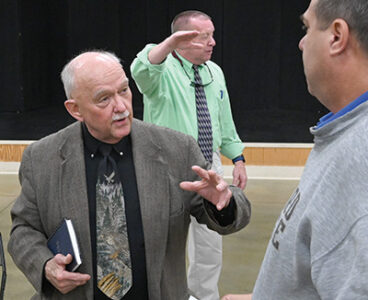Murrells Inlet
Scientists highlight impact of pet waste on shellfishing

Nearly a third of the shellfish beds in the state’s seafood capital are closed to harvesting because of high levels of bacteria in Murrells Inlet. Many residents say that is the result of development that has increased stormwater runoff.
A researcher says it’s poop.
“Most of the bacteria coming into the estuary is coming from your dogs,” Geoff Scott, who chairs the Department of Environmental Health Science at the USC School of Public Health, told residents at a Creek Talk this week.
He recalled giving the same report back in the 1990s, when the series was known as Chowder Talk and came with a light meal.
Scott and Dwayne Porter, director of graduate studies at the school of health and director of geographic information programs at USC’s Baruch Institute, did studies comparing the health of Murrells Inlet’s urbanized estuary and the undeveloped North Inlet estuary.
“Murrells Inlet was our living laboratory to finalize and figure this stuff out,” Scott said.
The closed areas account for 31 percent of the inlet’s shellfish beds, said Michael Hodges, a biologist with the state Department of Natural Resources who works with oyster reef restoration. The areas that are subject to annual restrictions are growing, he added.
“This is a high pressure harvesting ground,” Hodges said. “We feel it is probably old septic systems.”
But Scott said the path to closure of the oyster beds began when the jetties were built to stabilize the actual inlet in the late 1970s. He pointed out at the time that the Army Corps of Engineers had data from other places that showed the jetties would reduce the amount of saltwater entering Murrells Inlet by 20 percent.
“Within two years of the completion of the project they started closing the shellfishing down,” Scott said.
Murrells Inlet is one of about 300 “pocket estuaries” from North Carolina to Florida. It isn’t formed by a freshwater river or stream. The only source of freshwater is precipitation.
Development along the water and in the larger estuary has an impact, Scott said.
That’s best seen through a type of bacteria called Vibrio, which can be deadly. When the bacteria find a reliable source of nutrients, they lose the appendage that allows them to swim.
“It’s been the best indicator of the state of the planet for 150 years,” he said.
When the natural landscape is replaced by a monoculture of lawns, Scott said, the molecules that kill Vibrio are removed.
“It’s like removing a natural antiseptic,” he said.
But when Chip Smith, a long-time environmental activist and organizer of the Creek Talk, posed the question of what single action could best help preserve Murrells Inlet’s water quality, Scott returned to pet waste.
When public sewer replaced private septic tanks in the early 1980s, it helped improve the water quality.
But researchers found that the major source of bacteria continued to be animal waste.
“Raccoons and deer get a pass. The pets are something we can do something about,” Scott said.
He did point out that it’s important to have wildlife corridors rather than conventional “green space” in developments, which only serves to concentrate wildlife.
“Don’t let someone convince you that green space is always the answer,” Scott said.
And Porter said the entire watershed needs to be the focus. Visitors who bring their pets to Huntington Beach State Park on the south end of Murrells Inlet are also a factor.
“You wouldn’t believe how many people are walking around with dogs,” Bob Steffens, who does water quality monitoring for Coastal Carolina University at Murrells Inlet 2020, said of the park.
Hodges suggested that a program in Charleston County to educate people about pet waste could be a model for the community and the state park. Preserving oyster beds is a much better strategy than trying to restore them, he said.
“Give the oysters a break,” Scott said. “The water will be a lot cleaner.”




